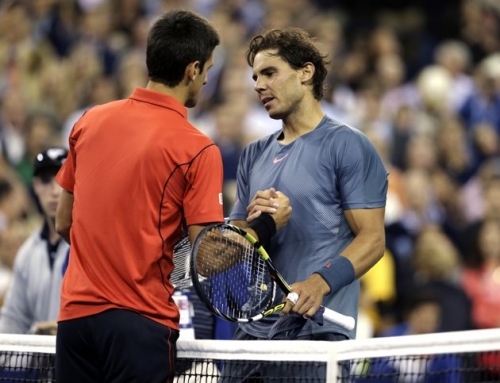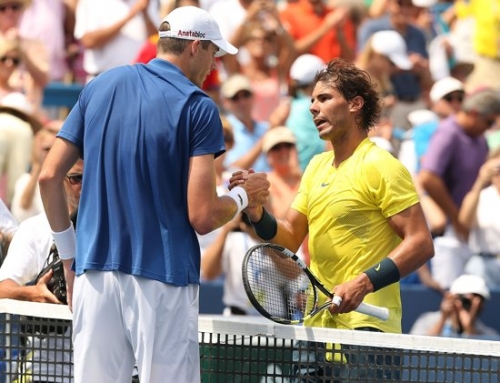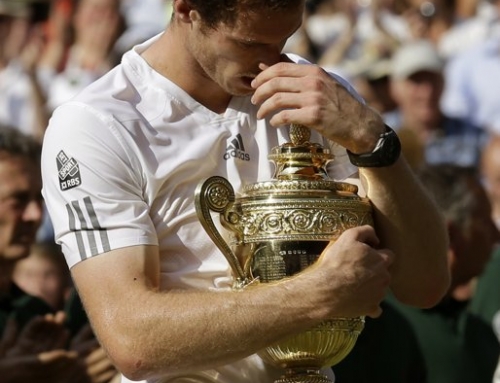
Sam’s game has evolved in the short time he’s been a pro. He’s always had the big serve. With a towering height of 6’6″, he’s part of a new breed of tall mobile big men of tennis that include pros like Marin Cilic, Tomas Berdych, Juan Martin del Potro, and fellow American and doubles partner, John Isner. What Sam has learned is simple: a big serve is not enough to win. You still have to play tennis.
A man of Sam’s height would have been a serve and volleyer in McEnroe’s day. Today, serve and volley is simply too dangerous. You need a serve that’s huge because players routinely stand many meters behind the baseline, to give themselves time to return the serve, and they take such big swipes from back there, that they aren’t in danger of being attacked. Such a strategy would probably have been deemed insane in the 1960s. A slice backhand would have floated its way to the net. A flat forehand would similar require time to get above and below the net. So players of yesteryear took their chances, stood their ground near the baseline, and occasionally got aced by the slower serves of the era.
These days, even a big man like Querrey needs to play from the backcourt, but these days, there’s a modification of the serve and volley. It’s the serve and forehand. Both Sam Querrey and John Isner have worked on the 1-2 punch. Put a big serve in, wait for the weak reply, go for the winner. This strategy works because the return of serve, when it comes back, may be one of the weaker shots a big man sees in a point.
Querrey has also devoted some time to horizontal movement, bringing him from the baseline to the net. This movement allows him to close on short balls and drop shots, which are exceedingly common on clay, and are also pretty common on grass. Querrey’s movement should, in all honesty, be a good tradeoff compared to his buddy John Isner. But Isner shows that there’s one more component to winning at the highest level–mental toughness. Even with a big server like Querrey sees break points. It’s the mark of a champion to put in big serves or play big shots in these moments.
Querrey’s match against Schuettler was quite telling. Although Querrey was holding rather easily, Schuettler was doing well because he was beating Querrey off the ground on his own serve. What Querrey needed to realize was that he was still holding serve easily and not to get discouraged. Fortunately, that is what he did, and the pressure of having to win so many points from the backcourt eventually took its toll on Schuettler.
Querrey has three weaknesses that he needs to work on. First, his return of serve. Like John Isner, Querrey doesn’t break that much. If he could ever start getting a strong return consistently in play, he could start to move up the rankings more. Querrey is hitting a glass ceiling based on his style of play. The only top 10 player that doesn’t have superior movement is Juan Martin del Potro. However, he moves at least as well as Querrey, and has a bigger serve, a bigger forehand, and a better backhand. Right now, del Potro is a more dogged opponent than Querrey, which is partly reflected in his personality vs. Sam’s.
But run down the top 10. Federer, Nadal, Djokovic, Murray, Davydenko all move very well. Then, there’s Roddick, who isn’t spectacularly fast, but he moves pretty well compared to, say, Querrey or Isner. Roddick also serves rock solidly consistent at 70%. That service percentage has as much to do with his success as anything else in Roddick’s game.
Robin Soderling moves pretty good for a biggish guy, perhaps about as fast as Roddick. Soderling is able to compensate for some lack of pure speed by bludgeoning the ball, and this often leads to weak enough responses that he’s in control of the point. Soderling’s never going to be known as a great defensive player.
Finally, Verdasco and Tsonga are pretty good movers as well.
In this game, it’s tough to win without moving reasonably well. But it’s also tough to win without some big shots. Querrey can hit a big winner off the forehand, but he’s not like Soderling, who can hit 4, 5, 6 shots in a row that are huge. That’s currently the difference between Soderling and Querrey. Grass helps Querrey out some because the surface helps his big serve. But Querrey can’t pound the ball on both sides as consistently as Soderling. Soderling has a better backhand and more power, over and over, on the forehand.
Querrey has tried to supplement his game with doubles, though he doesn’t come to net all that often. It’s similar to the Stosur game where she used to play lots of doubles, but doesn’t come in to net as much as she could, partly because her ground game is so formidable.
To get to where Querrey currently is, he’s done three things. First, shore up weaknesses in his game. That included lacking a big shot. His forehand was big for the juniors, but it wasn’t big enough for the pros, and he’s stepped that up. Second, he’s worked on his foot speed. Big guys generally don’t move as well.
The third thing that he’s had to work on, and is still working on, is his mental toughness. You need some amount of mental toughness to be in the pros, but since his game is predicated on holding serves easily and then trying to break, he has to be tough when he is in trouble on his own serve.
Right now, Querrey lacks a little versatility in his game. It would help if he either moved even better or hit even bigger. He needs to improve his two-hander a bit more, make the down-the-line backhand into a weapon.
Still, the upward progress of Sam Querrey, while not exactly meteoric, is steady. He continues to go deep in tournaments, at least the smaller ones. He now needs to make a big breakthrough at a Slam, reach the quarters. Grass seems like his best chance. Can he do it?




![[US Open Men’s Final] Can Djokovic beat Nadal in the finals?](https://www.essentialtennis.com/wp-content/uploads/2013/09/20130909djokovic-500x383.jpg)


![[French Open] The tactics of the Djokovic-Nadal semifinals](https://www.essentialtennis.com/wp-content/uploads/2013/06/20130607nole-500x383.jpg)